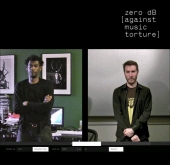On the Attack (Denver Westworld, 27th April 2006)
Massive Attack is more dangerous than ever.
When I'm sitting on airplanes, people will look at me and ask, 'Are you in a band? And what kind of music do you make?'" notes Robert del Naja, who raps and conceptualizes for Bristol, England's Massive Attack under the pseudonym 3D. "I say, 'We're kind of an experiment, and we make experimental music.' And normally, that either satisfies their curiosity or frightens them off for the rest of the flight."
Those who clam up or flee upon receiving this response are missing out on a conversation with a performer who's consistently intriguing and unexpectedly forthright. As the only person who's been involved with every permutation of Massive Attack since its 1987 inception, del Naja has unique insight into the group's work, which qualifies as some of the most influential popular music made during the past two decades. Moreover, he's candid to a fault, and willingly addresses even potentially unpleasant topics, including discord with fellow Attackers and his February 2003 arrest on charges that he downloaded child pornography. Police dropped the child-porn investigation less than a month after the bust, but knowing that the incident was spurred by what del Naja calls "entirely false information" didn't make the process any less traumatic. "It was like being in my own personal fucking Kafka movie," he declares.
Today the picture is much better. Massive Attack recently issued Collected, a two-CD compilation that does a fine job of documenting the group's many achievements to date, and del Naja and Attack co-founder Grant "Daddy G" Marshall are assembling tracks for a new disc to be named Weather Underground with the assistance of Dave Sitek from TV on the Radio, among others. Not that they're spending a lot of time shoulder to shoulder. In a March interview with The Independent, a British publication, Marshall said, "I haven't worked with 3D for six or seven years now. We don't like each other very much. It's always been quite tempestuous for us in the studio."
"G chooses his words pretty well," del Naja says in response to Marshall's Independent quote. "Things have been set up for a studio in Bristol, and he's started going back -- he's starting to write again. But he hasn't really been doing that for the past seven years. So as much as there's a little bit of tension between us, and always has been, a lot of the time the tension has been created in my eyes because he hasn't been coming to the table with anything to offer. And I was getting frustrated that I seemed to be carrying the can for the whole band. But now that he's working again, I think it's cool, and I think it's good he's doing it in his own space. I need my space to develop my ideas, too.
"The great thing about Massive Attack is that it's a magnet that draws you," he goes on. "You can work on it, or you can move away from it if you're not into it. But it's something that's always there."
So it must seem to del Naja, who's been involved with Massive Attack or its immediate precursor for nearly all his adult life. He was initially known not as a musician, but as a teenage graffiti artist -- yet his connection to Bristol's underground naturally attracted him to the Wild Bunch, a DJ-driven sound system that paid homage to the Jamaican party-givers whose impromptu toasts helped birth hip-hop. When the system shut down toward the end of the '80s, Marshall and fellow Wildmen Andrew Vowles (better known as Mushroom) and Nellee Hooper, of Soul II Soul fame, hooked up with del Naja to form Massive Attack. Together with ancillary associates such as rapper/growler Adrian Thaws, who goes by Tricky, and Shara Nelson, a remarkably evocative vocalist, the crew crafted 1991's Blue Lines, the rare disc that invented its own genre. "Safe From Harm," which kicks off both Lines and Collected, merged soul, funk, hip-hop and electronic music in such a dark, atmospheric and compelling way that performers are ripping it off to this day.
Massive's core collaborators were still together for 1994's Protection, an opus almost as absorbing as the outfit's debut. However, things began to unravel during the sessions that resulted in 1998's Mezzanine. The group's sound shifted in a harsher, more guitar-heavy direction pushed by del Naja, and Vowles was not pleased. He eventually split, and because Hooper chose to focus on other projects, del Naja and Marshall were all that remained of the original brain trust. Against all odds, Mezzanine succeeds anyhow; tracks such as the grinding "Inertia Creeps" practically crackle with drama. But even if the behind-the-scenes conflicts added to the twisted energy of these recordings, del Naja doesn't think instigating intra-band warfare is a smart artistic strategy.
"There's been some great things that have come out of that friction," he admits, "but there have also been a lot of wasted great ideas as well -- past moments that were wasted because of the different personalities, or because we weren't getting each other then, or because we weren't giving each other the time or space to get each other. There are a lot of things that haven't been heard, a lot of things that have never been completed or didn't get a chance to evolve. So for as many good things as there were, there's also that negative side."
Matters got worse when it came time to make Mezzanine's sequel, 2003's 100th Window. While Marshall didn't formally break with the combo, he decided not to participate, leaving del Naja to cobble together songs with the assistance of previous Massive contributors like vocalists Horace Andy and Elizabeth Fraser (of Cocteau Twins fame), plus Neil Davidge, who co-produced Mezzanine. The results weren't bad, but neither were they as groundbreaking as previous Massive Attack efforts -- and since del Naja was the only person left to blame, he took the brunt of the criticism.
By Michael Roberts
http://www.westword.com/Issues/2006-04-27/music/music.html








